5.1 What are Non-Fungible Tokens (NFTs)?
Stop overpaying - start transferring money with Ogvio. Sign up, invite friends & grab Rewards now! 🎁
Many people who have gotten into NFTs will tell you that the learning curve is really confusing. Both crypto experts, and also traditional artists that have never heard about blockchain technology before are going to have completely different outlooks on what an NFT is, and what it can be used for.
Personally, I believe that everyone should have at least a fundamental understanding of NFTs since they are becoming increasingly more popular by the day. Understanding the concept will surely help you clearly see what NFTs are and why they are so valuable.
In this section, we’re going to take a good look at NFTs - specifically, what they are, where they come from, why they are so expensive, and how you can purchase or even create them yourself. And don’t worry - we’ll avoid any and all technical jargon, and only introduce industry terms when they’re absolutely essential to the context of the section.
So, let’s dive in!

Video Explainer
Video Explainer: What are Non-Fungible Tokens (NFTs)?
Reading is not your thing? Watch the "What are Non-Fungible Tokens (NFTs)?" video explainer
What is an NFT? (Explained with Animations)
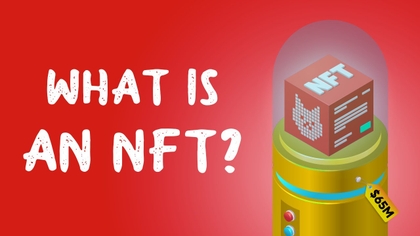

What are NFTs?
An “NFT” is a “non-fungible token”. “Non-fungible” is a fancy way of saying that something is completely unique, and cannot be replaced with something else.
For example, think of your car (of course, if you have one) - sure, there are other cars out there that are probably just like yours, but they’ll have different mileage, different tires, engines, personal interior gadgets, various dings & dents, or even those stupid stickers on the trunk. All of these things make your car UNIQUE - there’s only ONE car purely like THAT!
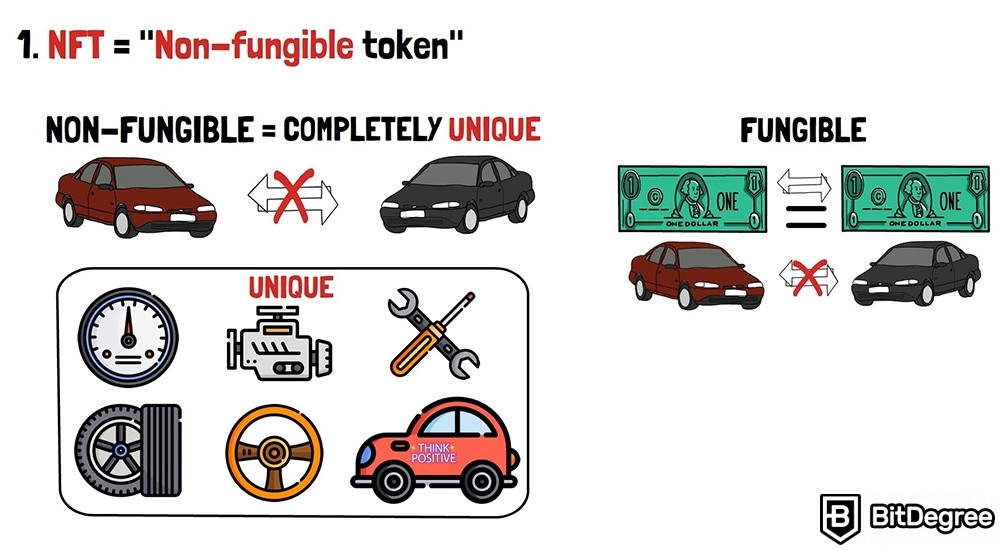
So, before we continue, an example of a “fungible” asset would be the value of a $1 bill. This is because the value of your $1 will always be equal to the value of another $1 bill, and you can trade your $1 for any other $1 bill out there - something you wouldn’t be able to do with your car.
Following that, a token is simply a digital asset.
Rather, tokens are used as representations of different asset kinds. Obviously, you can’t physically take your car and just put it into the internet, as you put it into your garage. That's why you need some sort of digital representation tool! And this is where tokens come in.
So, if you have a car, you could create a token to represent that car on the internet, as a physical object. Although there’s much more to it, in this context, you can think of it as a digitalized version of a physical item.
Moving on and continuing with that car example, let’s imagine you have taken a picture of your car, and later created a digital token for it - this would be the NFT of your car! It’s “non-fungible” since it’s unique, and it’s a token since it’s not the actual car, but rather, a digital representation of it!
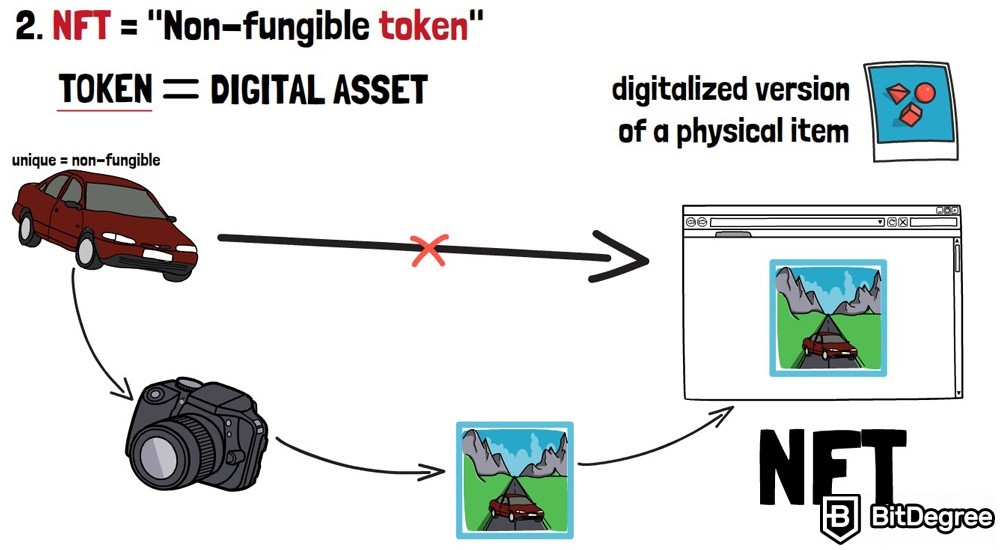
Most people associate the term NFT with trading cards, digital artwork, or in-game items and characters. It’s important to understand that the NFTs themselves aren’t the actual assets, but rather, representations of those assets on the blockchain.
Now, blockchains are essentially data storage locations - virtual databases, if you will. If you were to create a unique token - an NFT - on a blockchain, it would receive a special code, which would be used to identify it in the future. Since blockchains are (mostly) public, everyone would be able to see that the token was both created by you and that it’s the original - not a copy-pasted version made by your friend or a random guy on the internet.
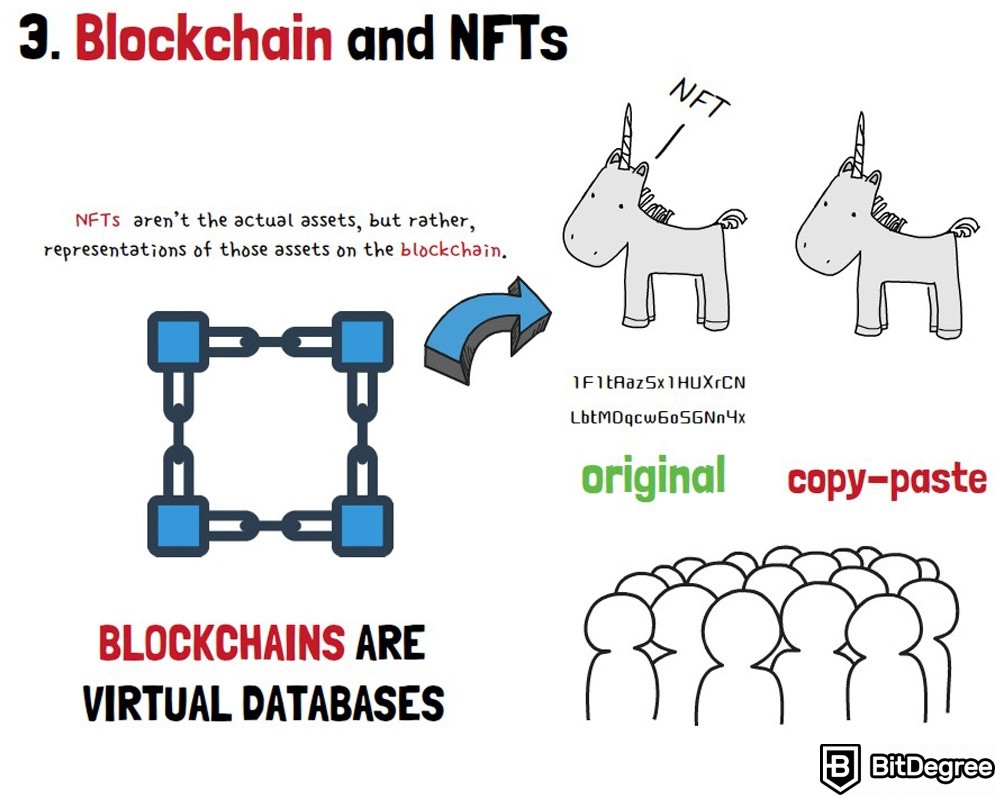
Heh, that’s a lot to wrap your head around, I’ll admit. But don’t worry - it gets easier from here.
Let me give you another example by referencing Twitter former CEO’s Jack Dorsey’s tweet. Dorsey created an NFT out of his first-ever tweet and auctioned it off for over $2,9 million.
Is the tweet available for everyone to see? Yes. However, the creator-signed NFT version of the tweet belongs solely to the individual who won the auction - this is very simple to prove with the help of the blockchain.
When viewed on the blockchain, NFTs are simply strings of data. This textual data references an image, a GIF, or any other asset that can be viewed on the exchange platforms where the NFT is located on. Thus, when you purchase an NFT, you actually purchase that referential data.
Now, this point is crucial to understand - if you own an NFT, it actually means that you own only that data. Not an image, nor a GIF, nor some sort of a virtual character - instead, you own the data that references the aforementioned assets. This data is encoded on the blockchain and references the place where the asset (picture, GIF, etc.) is located (the server).
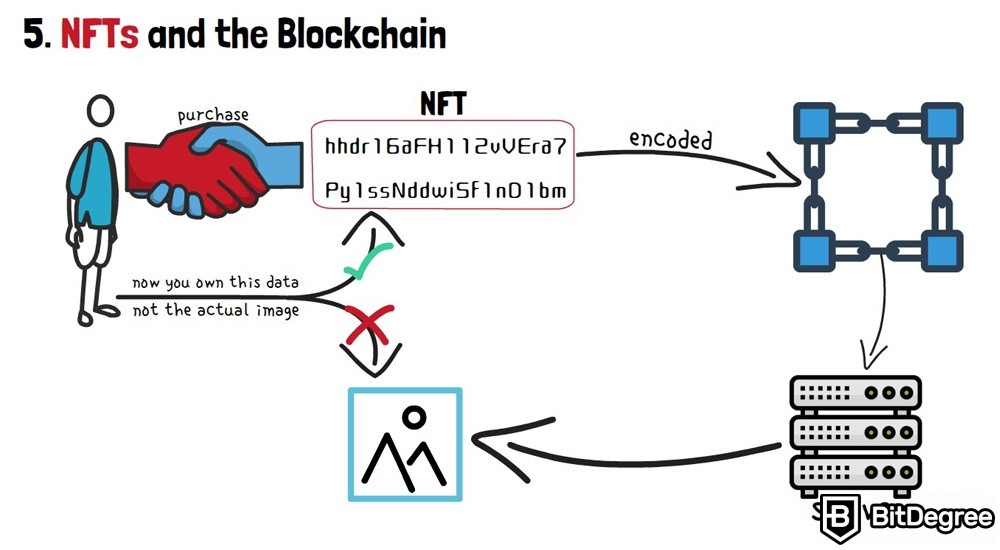
Theoretically, the marketplace platform could swap out the image on their servers, and your data would point to a different picture of GIF than the one you’ve bought! Also, the image can simply be deleted from the server - your data on the blockchain, on the other hand, can not.
Personally, this idea always bothered me the most, when it comes to NFTs. However, when you understand that you don’t own the actual image, but rather, the data on the blockchain, things start making much more sense.
So, why do people buy NFTs, and why are some NFTs priced as high as they are? I mean, the earlier-mentioned Jack Dorsey’s tweet is a good reference here as well as some of the image collections from the popular NFT creators like CryptoPunks or Bored Ape.
Well, there are actually a few things that lead to NFTs being as desirable as they are.
For starters, they are a true innovation in the first place, and as most have heard, also an easy way to invest and get some profits. NFTs are the first phenomenon of this kind, and people still don’t really know what to make of them. Should they purely become a future art? Maybe the gaming industry could benefit most from them? Is there any utility for an NFT?
These questions showcase that NFTs are still very new, and people are attracted to innovations that may potentially prove to be a good investment.
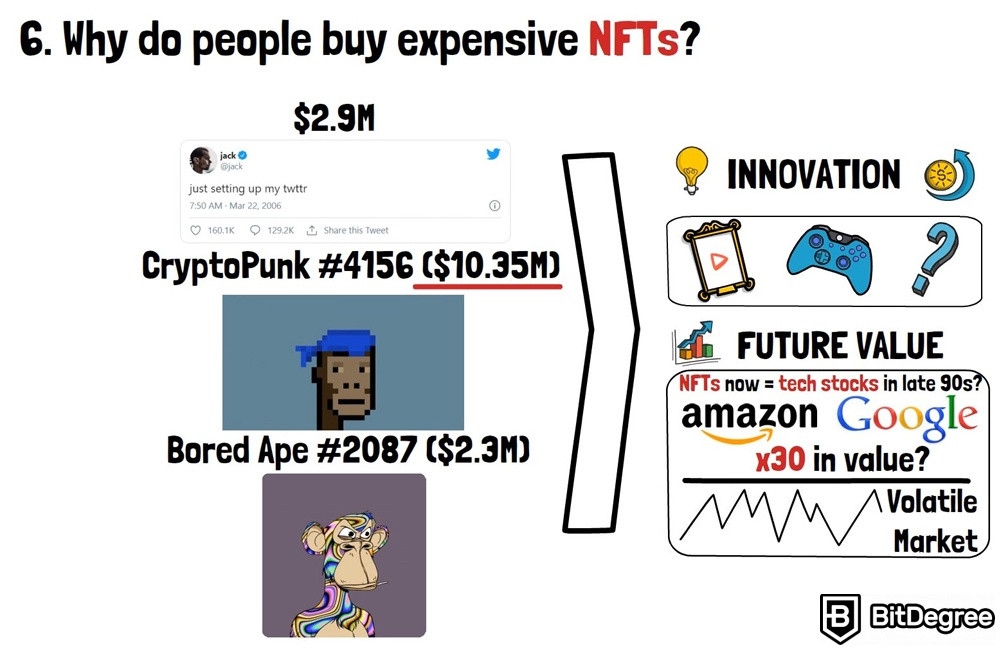
This is actually the second big reason behind their popularity - the speculated value of what NFTs will be worth in the future. Some people compare NFTs to tech stocks back in the late 90s and the early 2000s. When the internet was still very young, people had no way of telling how much Amazon or Google stocks would be worth in a couple of decades.
Nowadays, though, you have some NFTs being sold for huge amounts of money. For example, one of the most expensive NFTs ever sold is Beeple’s “EVERYDAY: THE FIRST 5000 DAYS” - it was sold for over $69,3 million. Following that, Beeple’s “One” was sold for $28,9 million. Some CryptoPunks have also been sold for anywhere from almost $8 million to over $10 million.
The parallel here is that NFTs are still a very new concept, and a volatile market to be entering. It’s like a carnival - everything’s shiny and colorful, you never really know what sort of cool attraction lies around the corner, and every once in a while, you may find yourself on a rollercoaster ride - the last part is true for many NFT prices.
This brings me to my next point - the reason why some NFTs are priced as high as they are. The answer here is actually very boring and simple - it’s a supply & demand type of deal.
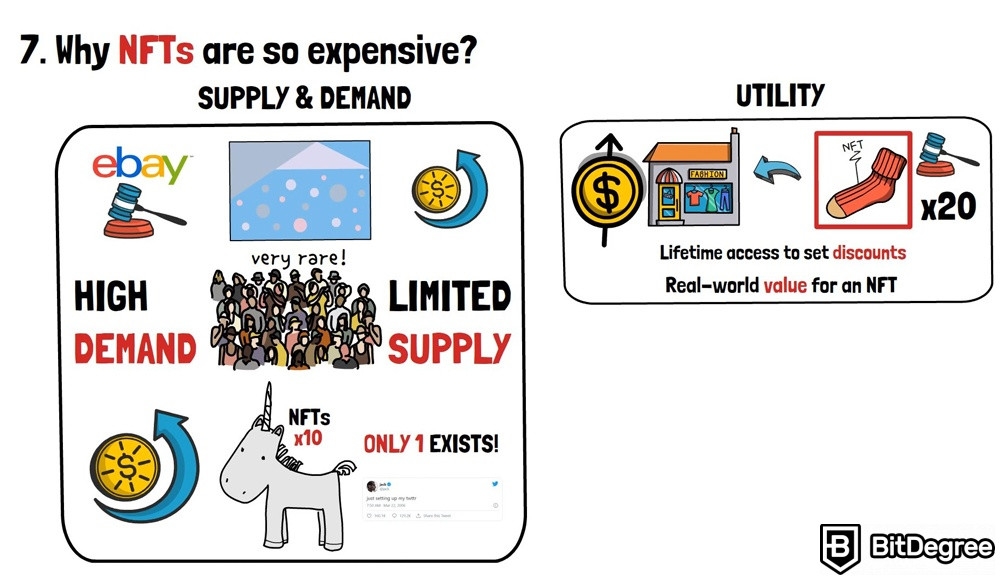
Imagine that you have a very rare painting. You decide to auction it off on eBay, without setting a minimum bid. Sure, someone may come around and offer a couple of dollars for the painting.
However, since it’s so rare, it’s highly likely to attract a lot of attention from art fans. This results in huge demand for something that’s very scarce - in other words, something that has a limited supply. This makes the price of the asset go up, exponentially.
The same is true with many NFTs, as well. If the token is part of an exclusive collection, and there are only 10 NFTs that will ever be created within that collection, this makes it desirable for a lot of people - hence, the price goes up.
Social influence and renown are often huge factors, as well. Once again, think about the earlier-mentioned Jack Dorsey’s tweet NFT. Being one of the founders of Twitter, Jack Dorsey is a prominent figure in the business world - naturally, him selling an NFT of his very first tweet on the platform that he founded would draw a lot of attention and interest!
Taking a step back, another reason why NFTs are as hyped up as they are is the utility factors. While most people assume that non-fungible tokens are merely used for collectible purposes, this isn’t necessarily true.
Imagine if your favorite clothing store would issue a set of limited NFTs. In addition to being some cool images or GIFs that you can acquire, each NFT would provide the holder with lifetime access to set discounts when shopping within the store. This is a case for the utility aspect of an NFT - in other words, it creates tangible, real-world value for a non-fungible token.
Combine this with the fact that there’s a limited number of NFTs available, and that all of them are auctioned off to the highest bidders, and this can result in some tokens possessing a huge price tag.
So, let’s recap. NFTs are valuable and sought-after because they are rare, might be created or owned by a famous or well-known individual, can provide tangible, real-world value, and are an innovation. The sum of these features leads to everyone, including their pets, having at least heard of NFTs, even if you know nothing else about the crypto space.
Now, when you think about valuable NFTs today, the first names that would probably come to my mind are CryptoKitties, CryptoPunks, Decentraland, the Bored Ape Yacht Club, and Banksy. This is fair - many of these NFTs were the catalysts that drove the relatively niche industry into the mainstream.
However, what was the very first NFT that was ever created? And when did this happen?
Surprisingly, it’s not any one of the names mentioned earlier. Instead, the very first NFT - of the kind that we’re used to today, that is - was created all the way back in 2014, by a man named Kevin McCoy. The piece is called “Quantum” and is up for sale for over $7 million dollars.
So, while pop culture-relevant non-fungible tokens helped bring mainstream awareness to the market, and exploded the topic into unparalleled popularity, artists have been experimenting with the technology long before that.
Finally, on the topic of experimenting with the technology, let’s now take a look at how YOU, - yes, YOU - can create an NFT of your own. Allow me to reassure you - while it may sound difficult from the sidelines, creating an NFT is actually very straightforward.
First things first - you’re going to need a cryptocurrency wallet. This will act as the storage area for your NFTs, and will also house the cryptocurrency needed to pay for the creation process of the token. Think of it this way - if an NFT is a car, then the cryptocurrency used to make it is gas. Without gas, the car is practically useless. Following this example, a crypto wallet would be like a garage for your car.
The most popular wallet in this regard is called MetaMask. It’s free to use, and you can download and install it as a browser extension. Once you set it up, you’ll be able to start using the wallet almost instantly.
Next up, you need to fund the wallet. This can be done by visiting an exchange platform and purchasing some cryptocurrency for fiat money. The currency that you’ll want to buy is known as Ether (commonly referred to simply as Ethereum).
Before we continue, though - why Ether? Well, the absolute majority of NFTs are created on the Ethereum blockchain. Thus, in order to pay for the creation process, you need to use the native currency of this particular blockchain - Ether.

Once you purchase Ether and transfer it from the exchange to your MetaMask wallet, you’re ready to go!
Now, you will need to visit what’s known as an NFT marketplace where NFTs are auctioned. Just like eBay or Amazon for traditional goods, NFT marketplaces allow you to browse through different non-fungible tokens, and bid, purchase or sell the ones that you like. On that note, these marketplaces also allow you to create NFTs on them in a simple and efficient manner. For the sake of this example, I’ll reference the most popular NFT marketplaces out there - OpenSea and Rarible.
What you’ll need to do is connect your MetaMask wallet to OpenSea - this is like creating an account on the marketplace. Once you do so, you’ll be able to start the NFT creation process - OpenSea has a very detailed tutorial that guides you all through the process, and even if it’s your first time, you shouldn’t face any struggles whatsoever.
Once you upload your picture or GIF and set all of the properties to your liking, all that you’ll need to do is create the NFT. Upon completion, your wallet address (the unique identification number of your personal cryptocurrency wallet) will forever be tied to the NFT, and no matter who owns it, you will always remain the verified creator of the asset in the blockchain log.
Moving on, now that you’re equipped with the knowledge of how NFTs are created, buying a token will seem like a super-simple process.
How to Buy an NFT?
In order to buy an NFT, you will need to have the same MetaMask wallet connected to OpenSea, and that wallet will need to be funded with Ether, as well. It’s not possible to purchase NFTs with fiat money, and thus, it needs to be exchanged for crypto.
With your wallet connected, you are now able to purchase your desired NFT (if it’s on sale) or bid on it at an auction. If you win, the token will be transferred to your wallet. That’s it - you’re a proud owner of a non-fungible token!

Make sure to keep your tokens secure, however - you could still store them in your MetaMask wallet, but if you want extra added security, you could also look into purchasing a hardware wallet (a physical crypto wallet device), and connecting it to your MetaMask.
Now as a recap, we took a good, non-technical look at the essentials of NFTs. We’ve covered what they are and what they aren’t, talked about their value proposition, and also covered the questions of how to create and purchase your desired non-fungible tokens.
Anyways, if you want to learn more about the MetaMask wallet, make sure to check out the section "What is the MetaMask?".










